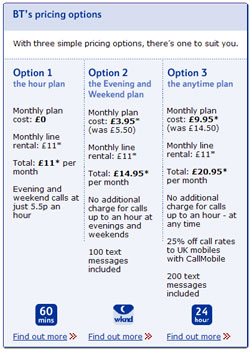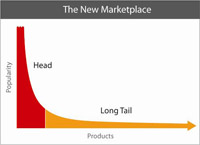 As of today BT is reshuffling its phone pricing structure. In a typical move of a power-crazed ex-monopoly, it’s giving with one hand and taking away with another.
As of today BT is reshuffling its phone pricing structure. In a typical move of a power-crazed ex-monopoly, it’s giving with one hand and taking away with another.
The ability to get going on this was given by Ofcom when they lifted restrictions on BT’s UK landline pricing structure.
The ‘giving’
BT hasn’t had the take-up with its bundled packages that it had hoped. From today, subscribers of its Option 2 & 3 package will receive around a third price cut. The included-evening/weekend calls to landline packages will move to £3.95 & the all landline calls to £9.95. This is the packages that they’re trumpeting – shame that most people won’t benefit from it isn’t it?
The other part BT is drawing attention to, is the reduction in price of calls to 0870 and 0845 numbers – the sort of numbers most people have been forced to call to speak to their banks. Oh … and they tell us that they’ve reduced the price of calls to mobile phones.
Almost to add insult to injury, BT is offering all of their 16m subscribes 25p off their monthly line rental at the end of the year- TWENTY FIVE PENCE! We’ve just wasted that typing this. Of course, much to our distress, most broadband services (supplied by BT Wholesale) need to pay the line rental. Why should we? and how much longer can this be allowed to continue? Come on Ofcom.
 The ‘taking’
The ‘taking’
The majority of BT’s 16m customers pay per call on the Option 1 scheme. Sadly for them, things won’t be such a bargain. BT is changing their standard charging unit from per second to per minute – not something that we’ve seen since the wild-west days of early mobile phone companies, where the cowboy operators tried to extract the maximum amount of money from the suckers customers.
We think it more than sneaky that BT have given people Call Minder, their free phone answering service, then charge people a fixed fee (3p) or ‘setting up’ the call, then charging whole minutes. When many people get an answer phone, they hang-up because they don’t want to leave a message, or to try to call their mobile – in the meantime BT will collect the setup fee PLUS a whole minute charge, for a couple of seconds.
As to how much the minute will be – we don’t know. We’ve looked, really we have, pretty hard too – we’ve even tried to use their price list search – but to no avail. Isn’t it a bit of a give away that if you need a search engine for your price list, you’re possibly going to be confusing the customer.
Interestingly, for the first time, BT have listed Skype on their pricing structure on the press release. Welcome to the future BT.
If you’ve got a couple of hours to spare, and fancy trying to extract pricing information, you can have a look at the BT Together site.
 Well they got there finally, Vodafone UK have announced that they’re releasing the less than catchy named Vodafone Mobile Connect USB Modem in the Autumn. It will support their 3G data service and, surprise, surprise, connect to computers using a USB lead. Rather neatly the software disks aren’t needed, as they’re installed directly from the modem.
Well they got there finally, Vodafone UK have announced that they’re releasing the less than catchy named Vodafone Mobile Connect USB Modem in the Autumn. It will support their 3G data service and, surprise, surprise, connect to computers using a USB lead. Rather neatly the software disks aren’t needed, as they’re installed directly from the modem. Yesterday, a spokesperson for the One Laptop Per Child (OLPC) programme revealed that Nigeria, Brazil, Argentina, and Thailand have all tendered commitments to purchase one million Linux laptops through the ambitious US-based programme.
Yesterday, a spokesperson for the One Laptop Per Child (OLPC) programme revealed that Nigeria, Brazil, Argentina, and Thailand have all tendered commitments to purchase one million Linux laptops through the ambitious US-based programme. This means that each laptop will be able to talk to its nearest neighbour and create ad hoc, local area networks for sharing data and connections.
This means that each laptop will be able to talk to its nearest neighbour and create ad hoc, local area networks for sharing data and connections. So far, AMD, eBay, Google, Nortel, Red Hat, and a number of other technology companies have all signed up to help support the project
So far, AMD, eBay, Google, Nortel, Red Hat, and a number of other technology companies have all signed up to help support the project BSkyB results for the last year were broadly in line with predictions, but seasoned watchers of all things financial, recognise tell-tale signs of a flattening of the growth curve. The company has managed its spend on programming well, but technology costs remain high, with significant outgoings on expensive High Definition equipment, that won’t bring instant revenue returns.
BSkyB results for the last year were broadly in line with predictions, but seasoned watchers of all things financial, recognise tell-tale signs of a flattening of the growth curve. The company has managed its spend on programming well, but technology costs remain high, with significant outgoings on expensive High Definition equipment, that won’t bring instant revenue returns. James Murdoch the CEO of BSkyB told the corporate world that “Our industry is changing faster than ever before and for Sky, 2006 has been an important and exciting year.”
James Murdoch the CEO of BSkyB told the corporate world that “Our industry is changing faster than ever before and for Sky, 2006 has been an important and exciting year.” Details are still a little murky on this one, but some information on the upcoming range 404, 504, and 604 PMP devices are bubbling on up on t’internet.
Details are still a little murky on this one, but some information on the upcoming range 404, 504, and 604 PMP devices are bubbling on up on t’internet. Accessories ahoy
Accessories ahoy To a long, long fanfare that we began to fear would never end, Top of the Pops, the world’s longest-running weekly music show, was finally killed off last night.
To a long, long fanfare that we began to fear would never end, Top of the Pops, the world’s longest-running weekly music show, was finally killed off last night. The figures back up the story too, with a recent survey revealing that people spend longer on the Internet than watching television, with the audience for Top of the Pops crashing to around a million viewers from its once-lofty peak of more than 15 million.
The figures back up the story too, with a recent survey revealing that people spend longer on the Internet than watching television, with the audience for Top of the Pops crashing to around a million viewers from its once-lofty peak of more than 15 million. Sharman Networks, the company that distributed the file-sharing software, Kazaa, has finally come to an agreement with the media companies that have been chasing them for years throughout courts around the globe.
Sharman Networks, the company that distributed the file-sharing software, Kazaa, has finally come to an agreement with the media companies that have been chasing them for years throughout courts around the globe. It’s understood that the settlement doesn’t require the media companies to provide their content to Kazaa, but equally it doesn’t forbid Kazza carrying copyrighted material, if done ‘legitimately.’
It’s understood that the settlement doesn’t require the media companies to provide their content to Kazaa, but equally it doesn’t forbid Kazza carrying copyrighted material, if done ‘legitimately.’ We’ve just published a
We’ve just published a  The Long Tail is an important manual for the new economics of the Internet and digital culture. As well as demystifying the numbers it provides an essential guide to how to navigate a world where everything is available, all the time. Score: 95%
The Long Tail is an important manual for the new economics of the Internet and digital culture. As well as demystifying the numbers it provides an essential guide to how to navigate a world where everything is available, all the time. Score: 95% The Long Tail effect is not limited to buying and selling, the process by which the book was written is a case in point. Anderson (editor in chief of Wired magazine) published the
The Long Tail effect is not limited to buying and selling, the process by which the book was written is a case in point. Anderson (editor in chief of Wired magazine) published the  Some have taken this to mean that Anderson is sounding the death knell for blockbusters, something which he was at pains to counter on his blog, “Hits Aren’t Dead” he said, “I never said they were. What is dead is the monopoly of the hit. For too long hits or products intended to be hits have had the stage to themselves, because only hit-centric companies had access to the retail channel and the retail channel only had room for best-sellers. But now blockbusters must share the stage with a million niche products, and this will lead to a very different marketplace.”
Some have taken this to mean that Anderson is sounding the death knell for blockbusters, something which he was at pains to counter on his blog, “Hits Aren’t Dead” he said, “I never said they were. What is dead is the monopoly of the hit. For too long hits or products intended to be hits have had the stage to themselves, because only hit-centric companies had access to the retail channel and the retail channel only had room for best-sellers. But now blockbusters must share the stage with a million niche products, and this will lead to a very different marketplace.”